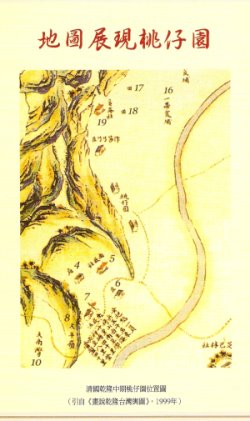Geographical environment and development in Taoyuan:
Located in northern Taiwan, Taoyuan county own unique excellent natural environment with mild climate and few natural disasters where most areas are platforms and plains except Fushin and Futou township composed of hills mostly. Irrigation is not complete and water transportation is not possible in the county as Cie-Dong and Nan-Kan streams can’t provide sufficient water. Early development is:
Hills in Taoyuan city surburb -Hutou Mountain
(Citation《Taoyuan History Volume》) |
|

|
 |
(1)The land transportation is disconnected by mountains and possible conflicts with natives. Water transportation was in operation between lower stream of Dahan river and Sin-Jhuang, Meng-Chia and Dan-Shuei(the lower stream of Danhan river flows into Dan-Shuei river). Early immigrants ever went to modern Taoyuan city from Nan-Kan River in the south (During the ruling of Emperor Kangsi). Development started from marine ports, Nan-Kan and Jhu-Wei and extended into the Taoyuan city in the south and Yang-Mei and Jhong-Li in the west.
Taoyuan county mapped in ruling of Emperor Gianlong, Ching Dynasty
(Citation from《Taoyuan History Volume》),edited from《Taiwan map in ruling of Emperor Gianlong》,1999) |
|
(2)Before the Han Chinese immigrated, most were Kai-Da-Ge-Lan tribe, a species of Ping Pu ethnics who were not good at agriculture and most regions were barren. A Cantonese, Syue, Ci-Long led hundreds of immigrants from Chuan, Chang and Zhou provinces in China in the 2nd year of Emperor Qianlong(1737) to develop (Note 1) the regions reaching Guei-Lun-Ling (Guei-Shan) in the east, and Kan-Zih-Chia (Nei-Li) in the west, and Nan-Kan in the north and Siao-Li in the south (Ba-De). In the 6th year of Emperor Qianlong, Syue, Ci-Long cooperated with Siao-Li tribe leader Jhih-Mu-Liou(Siao, Na-Ying (Note 2) |
Modern Taoyuan Canal【Ba-De and Guang-Fong section exit】(Photo by Chian, Jhong-Yi)
Siao-Li Canal was transformed into Taoyuan Canal and also the first canal longer than 20,000 kilometers in Taiwan. |
to collect farm rental to build Jhih-Siao-Li Canal (transformed into Taoyuan Canal) to establish farming in large scale. |
|
(3)Except natural environment, the factors influencing agricultural development included:conflicts between Han Chinese and native tribes because of different customs;Ching dynasty’s unstable and uncertain policy concerning immigration to Taiwan;plagues and epidemics;fighting with weapons between groups of people and life and property threats from robbers and thieves. Due to these problems, government administration was thus established to maintain public security and order(Note 3 )and to continue castle defense and irrigation and water conservancy constructions(Note 4)and to make regional development by the government and build temples in memory of ancient sages for the social public to make praying for blessings and disaster relieving ……•••All those promoted more immigrants from Fujen and Guangdong provinces to develop more fertile farmland gradually and to make Taoyuan evolving from few streets to a city.
The worship for Jing-Fu Temple followed immigrants and make the temple developing into a regional religious belief center. That Jing-Fu Temple’s developed from humble beginnings and through hardship to well establishment is highly relative to that Taoyuan city developed into prosperity with peaceful ethnics and union defense. |
Interpretation:
- Before Syue, Ci-Long, there had already some immigrants during the ruling of Emperor Kangxiand and Emperor Yongjheng, such as:Lan, Yong from Chuan province, Chen, Yu from An-Si county, Chuan-Jhou province and Guo, Guang-Tian from Chang-Jhou province. Syue, Ci-Long is selectively record in this writing because the subject of this writing is highly relative with the facts he established canal system and donated land for building temple.
- Jhih-Mou-Liou, see《Taiwan History Disctionary》,Syu, Syue-Ji et al, Published by Council for Cultural Affairs(2004),Page 0510
- At the 16th year in the ruling of Emperor Gianglong, Ching Dynasty(1751), 「Three Quick Mission Agency」was established in modern Taoyuan city and a 「chief director」was appointed for governing civilains’ affairs. See《Taoyuan City Diary》
- In the 50th year of Emperor Gianlong(1785), Wu, Jhong-Li re-promoted building Siao-Li canal system irrigating more than 300 plots of land after the completion of construction. See《Jing-Fu Temple Major Event Records》
|
|